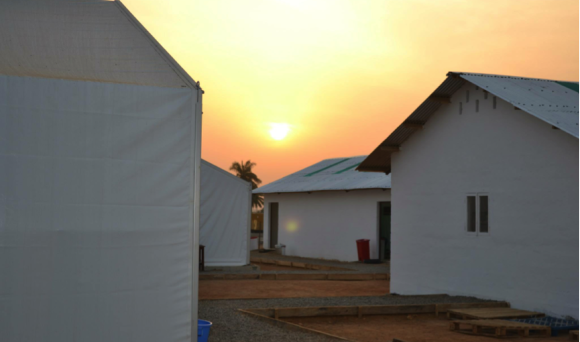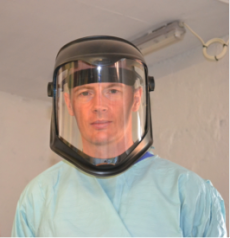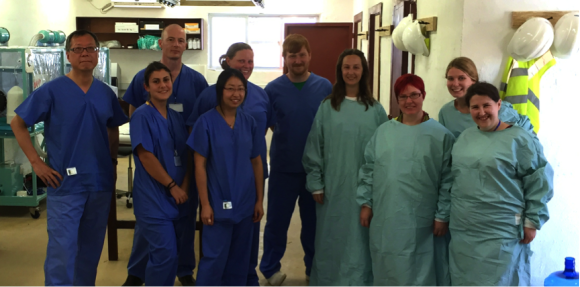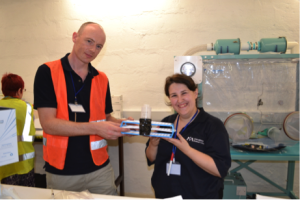
What is your day job? Tell us a bit about your research…

My main research focus is virus-host interactions, focusing primarily on noroviruses, the major cause of gastroenteritis in the developed world. We’ve used a variety of approaches to try to understand the viral life cycle and more recently have taken the first steps towards the identification of therapeutic approaches for the control of norovirus infection in patients. My interests have recently spread into other areas of virology such as the zoonotic potential of viruses and host responses to viral infection.
I’ve been fortunate enough to be supported by the Wellcome Trust my entire independent scientific career (some 13 years now); initially via a Career Development Fellowship, then subsequently by a Senior Fellowship, which was renewed in 2012. The funding, and the other forms of support, I have had from the Trust over the years have been instrumental in the success of the lab.
Why did you decide to go to Sierra Leone?
I could not sit by and watch the situation unfold without trying to do something to help.
I finally made the decision to go to Sierra Leone during the late summer of 2014 after following the media coverage of the Ebola outbreak closely over the preceding months. The coverage was harrowing, particularly for a virologist, as I understand how, with the right expertise and infrastructure, it is relatively easy to contain Ebola. The combination of urbanization and underdeveloped healthcare systems created a ‘perfect storm’ type scenario for Ebola to establish a foothold in West Africa.
There is one article in the New York Times that I will never forget. It describes the awful situation in Makeni, which was where I was finally based for my trip, and is the second largest city in Sierra Leone. The accompanying picture will always stay fresh in my mind; it shows a young child, lying on a floor covered in bodily fluids.
I could not sit by and watch the situation unfold without trying to do something to help.
After several months of trying to find a way of helping, I eventually managed to get in touch with Save the Children, who passed my details on Dr Tim Brooks. Dr Brooks is the Public Health England (PHE) lead for the laboratories in Sierra Leone, and along with a few other very hard working individuals at PHE, has done a truly amazing job at establishing the diagnostic capabilities in Sierra Leone.
Surprisingly, there is a relatively small group of people involved in supporting the laboratories in Sierra Leone and they have all done a fantastic job. Many of them, including Tim and the other senior managers, have been away from their families for many months and have not had a single day off since arriving in Sierra Leone. It’s been a real pleasure working with them.
I was in Sierra Leone for around five weeks, but I hope to return several times over the next 12 months. The outbreak is far from over and I, like many others, suspect it will be a long and bumpy ride so we need to continue our efforts.
What were your first impressions when you arrived – did things seem better, worse, or the same as media reports had described?
The first impressions were much better than I had thought. The few media reports that made it to the UK during the summer would lead you to believe that the epidemic had caused an almost complete breakdown of society in Sierra Leone. While there is a clear impact, the vast majority of the population appear to be going about their everyday life as normal. There were plenty of roadblocks, bleach buckets outside every building and lots of notices highlighting the dangers of Ebola, but otherwise the main population appeared to be going about their business.

What was your role in Sierra Leone?
I was part of a team of 10 volunteers from various parts of the UK sent by PHE to establish a diagnostic facility in Makeni. We were the first team to be deployed to Makeni and we deployed under the umbrella of International Medical Corps to work at an Ebola treatment center (ETC) built by the Royal Engineers and funded by the UK Department for International Development.
The team was made up of several biomedical scientists from the UK, research staff from PHE Porton Down and two academics from UK universities. We spent one week training at Porton Down prior to our deployment. The training team at Porton Down were fantastic and provided us with an excellent grounding in the procedures we would use in the lab.
The first week or two was spent primarily moving equipment by hand around a very busy building site. Equipment and reagents would turn up on the back of lorries and need to be manually unloaded. Moving over 10 tons of equipment and reagents around the site manually in the heat and humidity was very difficult but the team managed well. There were a couple of cases of heat stroke, lots of blisters and bruises, but the team all worked together to get the job done.

Several important pieces of equipment and reagents got lost on route, so we constantly had to improvise – for example, using empty fabric spray bottles purchased from the supermarket as bleach sprayers. One particularly ingenious improvisation was turning a disposable ketchup bottle and cotton bud holder into a container for the decontamination of pipette tips.
Once the lab was established we settled down into a shift pattern that meant people typically worked around eight/nine hours per day and had one day off in every nine. It was important to make sure the team was not tired to ensure the safe operation of the lab at all times. Some days inevitably ended being much longer, particularly if it involved travelling to one of the other PHE labs to pick up equipment or reagents.
Why is this work important?
One of the main difficulties, particularly before the three PHE labs were established in Sierra Leone, was trying to determine who had Ebola and who did not as there are many other diseases that have similar symptoms – malaria being one of them.
Prior to laboratory confirmation, the patients are often kept in hospitals or holding centers, which typically contain a mix of both Ebola positive and negative patients. As soon as a patient is confirmed, they are then moved to an Ebola treatment center.
Every minute an Ebola positive patient spends in a holding center with patients that do not have Ebola, greatly increases the chances of the disease spreading further.
Every minute an Ebola positive patient spends in a holding center with patients that do not have Ebola, greatly increases the chances of the disease spreading further. Therefore there was an urgent need to speed up the time between the samples being collected to the lab results being reported.
This was also true for any deaths in the community; all corpses were swabbed and tested. If the results were positive then the entire family were placed in quarantine and monitored for 21 days. The three purpose built PHE laboratories more than doubled the diagnostic capacity of Sierra Leone and results are now typically reported back to the clinicians the same day the samples were taken. Previously this would have typically taken two to five days.
What more needs to be done to tackle this outbreak?
In my opinion I think the international community needs to continue their efforts until every last case is identified and isolated. The history of epidemic has clearly shown us that it can very easily come roaring back.
I still feel that a key point will be to ensure all agencies engage properly with the community.
Do you feel optimistic that we can bring this epidemic under control? Are things starting to improve?
All indications are that we are beginning to see signs that the efforts are having an effect. I am very optimistic but I am also very cautious, as I know that any let-up in the efforts could result in a rapid rebound of the epidemic. Many of us feel that there will be a long and bumpy tail to this epidemic.
What was it like working away from home over Christmas?
In the end I was actually able to change my return flight and get home for Christmas. The lab team that followed us was larger than we had initially anticipated so they had more than enough people to keep the lab at full capacity.
Did anything surprise you while you were out there? What were people’s reactions to your presence?
The people of Sierra Leone were very welcoming. The children would run out to say hello to you. We had many people come up to thank us for all our efforts. There was no hostility towards the overseas workers at all.
One thing that did surprise me is the sheer number of people in Sierra Leone that have their own small businesses. It appeared that almost everyone was selling something. The streets of Makeni were lined with small stalls and full of people selling all kinds
How did your friends, family and colleagues feel about you being out there?
I am very fortunate in that my wife, colleagues and close relatives have all been very supportive of my efforts to help in Sierra Leone. My wife has been very understanding and fully supported my decision to go to Sierra Leone. With two young children under the age of seven, and a job, she has had a very busy time when I was in Sierra Leone. As a virologist herself she also recognizes the risks associated with the work.
Until now, I had never really appreciated the impact of this type of work on the relatives of aid workers and volunteers in these environments.
Until now, I had never really appreciated the impact of this type of work on the relatives of aid workers and volunteers in these environments. They typically have only the media coverage as a source of information, which can often paint a very distorted picture of the situation on the ground.
My department and the university have also been very supportive. Sending academics to these types of environments is not without its potential consequences. Thankfully, I work for an institution that has a strong commitment to global health at all levels. The university has a particular interest in supporting health and sustainable research in Africa through its Cambridge-Africa programme. They therefore recognize the need to support these efforts by making best use of the expertise within the university.
What are your takeaway thoughts from this experience? What can we learn from this epidemic?
I feel incredibly fortunate to have been able to make a small contribution towards the efforts to control the epidemic, however there is a lot of work still to be done. Firstly, the epidemic is not over, so until no more cases are occurring, the international efforts must continue.
Secondly, the epidemic has had a huge impact on both the healthcare system and the economy of all the countries involved. It will be sometime before we know the true impact of the epidemic but its effects stretch much further than the individuals that were infected.
In the longer term I very much hope that this epidemic has highlighted how important it is that nations work together with African countries to establish effective monitoring and healthcare systems. With increased urbanization occurring in many of these countries, it is highly probable that incursions of highly pathogenic viruses will be a regular occurrence. We cannot be reactive; we need to take steps now to prevent this from happening again.
You can learn more about the Wellcome Trust’s work to tackle Ebola in this blog post.
Comments